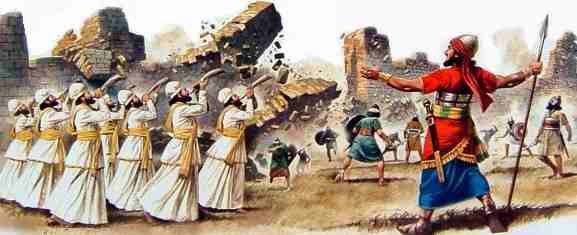MECHANICAL RESONANCE OF SOUND IN JERICHO WALL
1370 B.C The Bible mention already the MECHANICAL RESONANCE OF SOUND:When Trumpets Sounded and the army shouted loud The City Wall of Jericho was collapsed.
When the trumpets sounded, the army shouted, and at the sound of the trumpet, when the men gave a loud shout, the wall collapsed; so everyone charged straight in, and they took the city.(Joshua 6:20)
This article is about mechanical resonance in physics and engineering. For a general description of resonance, see resonance. For mechanical resonance of sound including musical instruments, see acoustic resonance. For the music album by American rock band Tesla, see Mechanical Resonance.

Graph showing mechanical resonance in a mechanical oscillatory system
Mechanical resonance is the tendency of a mechanical system to respond at greater amplitude when the frequency of its oscillations matches the system's natural frequency of vibration (its resonance frequency or resonant frequency) than it does at other frequencies. It may cause violent swaying motions and even catastrophic failure in improperly constructed structures including bridges, buildings and airplanes—a phenomenon known as resonance disaster.
Avoiding resonance disasters is a major concern in every building, tower and bridge construction project. The Taipei 101 building relies on a 660-ton pendulum — a tuned mass damper — to modify the response at resonance. Furthermore, the structure is designed to resonate at a frequency which does not typically occur. Buildings in seismic zones are often constructed to take into account the oscillating frequencies of expected ground motion. In addition, engineers designing objects having engines must ensure that the mechanical resonant frequencies of the component parts do not match driving vibrational frequencies of the motors or other strongly oscillating parts.
Many resonant objects have more than one resonance frequency. It will vibrate easily at those frequencies, and less so at other frequencies. Many clocks keep time by mechanical resonance in a balance wheel, pendulum, or quartz crystal.
The 1940 Tacoma Narrows Bridge, the first Tacoma Narrows Bridge, was a suspension bridge in the U.S. state of Washingtonthat spanned the Tacoma Narrows strait of Puget Sound between Tacoma and the Kitsap Peninsula. It opened to traffic on July 1, 1940, and dramatically collapsed into Puget Sound on November 7 of the same year. At the time of its construction (and its destruction), the bridge was the third longest suspension bridge in the world in terms of main span length, behind the Golden Gate Bridge and the George Washington Bridge.
Construction on the bridge began in September 1938. From the time the deck was built, it began to move vertically in windy conditions, which led to construction workers giving the bridge the nickname Galloping Gertie. The motion was observed even when the bridge opened to the public. Several measures aimed at stopping the motion were ineffective, and the bridge's main span finally collapsed under 40-mile-per-hour (64 km/h) wind conditions the morning of November 7, 1940.
Following the collapse, the United States' involvement in World War II delayed plans to replace the bridge. The portions of the bridge still standing after the collapse, including the towers and cables, were dismantled and sold as scrap metal. Nearly 10 years after the bridge collapsed, a new Tacoma Narrows Bridge opened in the same location, using the original bridge's tower pedestals and cable anchorages. The portion of the bridge that fell into the water now serves as an artificial reef.
The bridge's collapse had a lasting effect on science and engineering. In many physics textbooks, the event is presented as an example of elementary forced resonance, with the wind providing an external periodic frequency that matched the bridge's natural structural frequency, though the actual cause of failure was aeroelastic flutter. Its failure also boosted research in the field of bridge aerodynamics-aeroelastics, the study of which has influenced the designs of all the world's great long-span bridges built since 1940.



Comments
Post a Comment